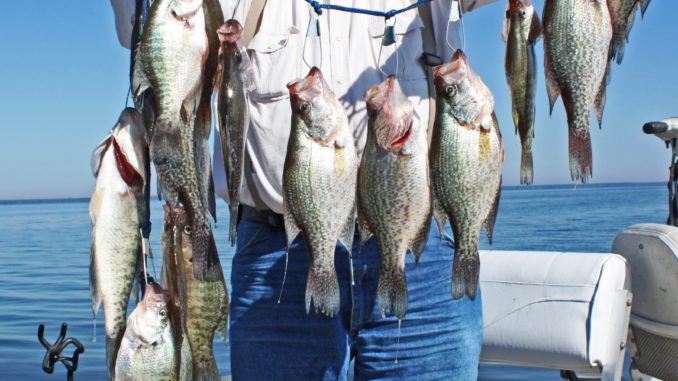
Live minnows fished around brush in 13 to 22 feet of water producing plenty of slabs
The past several weeks have seen the crappie fishing hit a fall peak on Lake Marion, according to guide Buster Rush.
“The good news is that it’s not over yet; it’s really peaking now,” Rush said. “The warm weather we’ve had has kept the water temperature up, and even with some chilly days we can expect the outstanding action to continue for a while.”
Rush guides out of Goat Island and the Taw Caw Creek area but fishes all over Lake Marion. His primary pattern – deep brush – has been extremely consistent.
“Some days the fish will change a bit in depth; crappie are very depth oriented,” Rush said. “Fishermen looking for slab crappie will do well to focus on sunken brush, logs or other debris. That is by far the most consistent pattern right now. We’ve had some big catches of huge fish recently.”
Rush (803-432-5010) said that some crappie are likely being caught by anglers fishing treetops, stumps and logs in shallower water, but for consistently success, he said deep water is best.
“We’re working water that ranges from about 13 to 22 feet deep,” he said. “Of course, I have a lot of brush piles I’ve put out, but some of the state’s fish attractors are producing very good action on big crappie as well. We caught 14 slabs on one the other day as fast as we could haul them in. Typically, the best cover will be along a drop or hill where there is some depth change to the bottom.”
“I’m using live minnows on a long rod with a light tip,” he said. “Instead of pulling several rigs like I would if spider-rigging, each fisherman holds a rod, and I position the boat right over the brush and use a couple of small split shots for weight and fish right around the top of the brush. We’re catching more fish this way because we can feel the light bite and present our bait exactly where it needs to be, right over or in the brush. If the fish are not hanging around the top, we’ll drop it a bit deeper and get it into the brush.”
This is where his unique method of hooking the minnow plays an important role.
“Sometimes we have to get the bait in the brush, and that’s why I hook my minnow with a No. 2 hook right thought the eyeball sockets and bring the hook back through the middle part of the minnow,” he said. “This makes the rig less likely to snag, plus it has the advantage of having the point of the hook in the middle of the minnow and we catch a lot of those short-strike type bites that are often missed. The minnow also has a discernible action to it. As I raise and lower the minnow around the brush it provides a good action and results in more bites.”
Rush likes to use small tuffy minnows and said those small minnows are a key to catching slab crappie.
“This time of the year, a small minnow works great,” he said. “I also like the tuffy minnows because they live longer and stay active after hooked. But when we get into a brush pile loaded with crappie, none of them last very long.”
Rush keeps his tackle simple, typically using 10-foot B ‘n’ M poles and light spinning reels loaded with 14-pound Trilene Solar Collector line.
“I’m a line watcher when crappie fishing, and sometimes a crappie will just slightly move the line. With this highly visible line, I’ll put more fish in the boat,” he said. “In fact, those real subtle bites are often from the biggest crappie.”





Be the first to comment